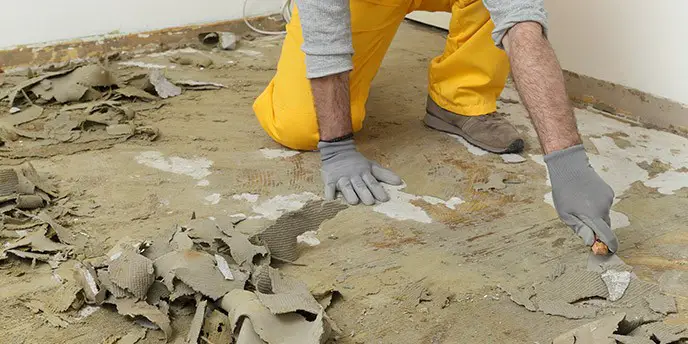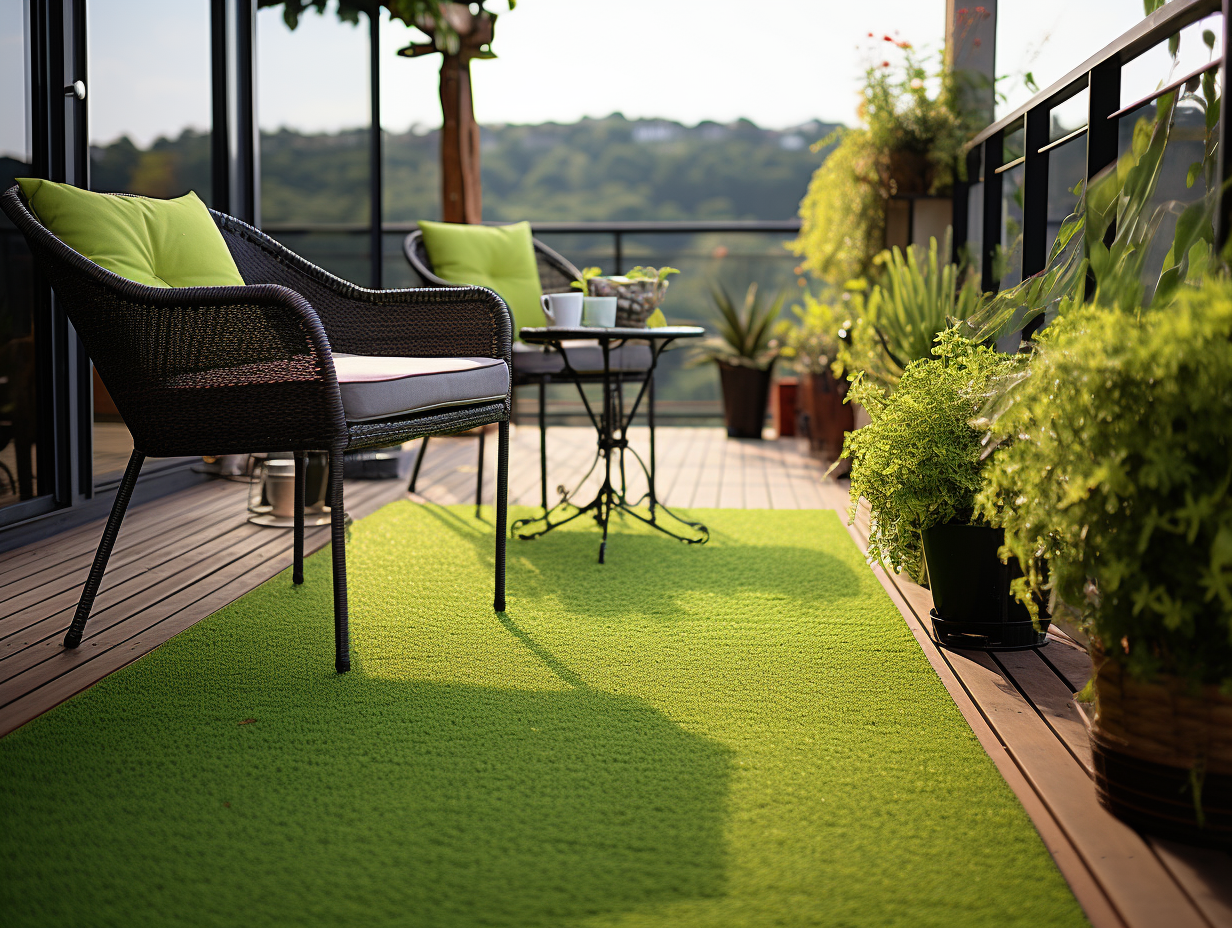The easiest way to remove carpet glue from a concrete patio is by using solvent cleaner and scraping it off with a putty knife.
Carpet glue is a sticky adhesive that attaches the carpet to the floor. When removing your carpet, you will inevitably have some leftover adhesive on the concrete underneath.
If you try scraping it off with a putty knife or other household tool, all you may do is make a mess of your floor and get more glue stuck in hard-to-reach places.
Removing carpet glue from concrete can be a very difficult task. This guide will show you the best way to remove carpet glue from your concrete patio and adhesive residue from your flooring and what tools you need to do it safely.

Materials & Tools
| Scraper | Gloves |
| Rag | Waterproof Boots |
| Knee Pads | Kettle For Boiling Water |
How To Remove Carpet Glue From Concrete Patio
Carpet gluing involves a tacky adhesive substance known as “carpet glue” being applied to the concrete.
This substance is then covered with a carpet and pressed into the concrete for an extended time, which allows it to absorb and harden in the material.
Removing carpet glue from concrete can be done by following several methods, depending on how deeply the carpet glue has been embedded.
To properly remove carpet glue from concrete, follow these steps:
1. Scraping

The first thing to do when trying to remove carpet glue from concrete is to scrape it off. Be aware that scraping will damage your concrete and may also spread the adhesive even more.
To prevent this, use a dull scraper so you can apply a lot of pressure without ruining your surface by scratching. Scrape in the direction of whatever fibers are sticking up, not across them.
If any residue remains on the concrete after you’ve scraped, clean it with water before proceeding or risk having solvent-based cleaners dissolve and re-spread it later in Step 5.
2. Softening With Solvent Cleaner

Use a non-flammable solvent cleaner designed for cleaning glue of patio concrete floors. These cleaners commonly contain either mineral spirits, xylene, or toluene.
Spray the cleaner onto the glue and wait for it to dissolve the adhesive. If you have an open flame anywhere, don’t use a flammable solvent-based product.
If no other type of cleaner is available, gasoline may be used but only if it’s stored in a non-glass container.
TIP: Also Try using boiling water to soften the glue.
3. Scraping Again And More Watering Down

After waiting 15 minutes for any solvent-based cleaner to do its job, scrape off the softened glue again before proceeding.
Use enough water from a garden hose so that whatever cleaner remains on your concrete will not re-adhere the glue to the surface.
Repeat this step several times during your cleaning process, scraping after each one.
4. Sanding
After wetting has penetrated the area thoroughly, use an oscillating floor sander (or rent one from a local hardware store) to sand down the area where the adhesive was applied on concrete.
Fine-grit sandpaper (180 grit) should be used in order to create an even surface that matches the surrounding concrete. It is important to keep the sanding area wet while removing any residue.
5. Washing With Water And A Power Washer
To remove any remaining adhesive and solvent cleaner, thoroughly wash your concrete with water from a garden hose and a power washer set on low pressure and which has an adjustable nozzle so you can use it as a mist rather than a straight stream of water.
Adjust the nozzle to shoot out a fine spray for whole-surface washing or in a semi-circle if you intend to scrub down only part of your garage floor.
Allow everything to dry overnight.

6. Washing With Water And Baking Soda
The final step is to wash your concrete floor with water and baking soda (or substitute another mild alkaline cleaner if using anything other than bicarbonate of soda).
This will neutralize any remaining acid from the previous solvent-based cleaners used during Step 2 and help remove all residue left by water only after washing in Step 4.
It’s important that this final step be done last because it’ll also neutralize your alkaline protectant.
General Tips: You can also substitute super fine steel wool for sanding paper to get rid of any remaining adhesion left by old adhesive after scraping it up. Just make sure to wear goggles to protect your eyes from any debris and wash the steel wool after you’re done (preferably before even touching anything).
What Dissolves Old Carpet Glue?
The short answer to your first question is mineral spirits (paint thinner). The long answer requires some additional information.
For a start, if the old carpeting was glued using an epoxy or urethane adhesive you are going to have a much tougher time removing it.
But even with water-based adhesive things get more complicated when you factor in the age of the glue and how long it has been exposed to heat from appliances, sunlight through windows, and the repeated opening and closing of doors every day.
Mineral spirits can do the job but be aware that they can also soften/dissolve whatever glues were used so only use them after testing on an inconspicuous area for colorfastness.
What will not do the trick? Anything caustic or acidic as these are going to eat through the flooring.
Also, any sort of oil-based solvents including kerosene and paint thinner (as opposed to mineral spirit) can also make your problems worse.
Will Vinegar Remove Carpet Glue?
Yes, it will remove the glue. It may lift the carpet’s backing though if not all of the glue was removed.
If the glues contain latex, vinegar (acetic acid) may dissolve it and remove it from whatever surface the adhesive is on.
The key to making this work is first knowing what type of glue you are hoping to get rid of before testing anything out.
Then simply apply vinegar to a cotton ball or paper towel and dab at any residue after allowing time for the original product time to dissolve and lift away easily with gentle yet firm pressure.
What Is The Best Product To Remove Glue From Concrete?
Generally speaking, there are two main types of glue that will need removal from concrete; water-based glues and solvent-based glues.
Each has their own respective strengths and weaknesses as well as methods that work better on one type than another. With this in mind, let’s take a look at each category separately:
Solvent Based Glue Removal From Concrete
In order to remove solvent-based glue from concrete, you will need to use a product that is solvent-based. These types of products can be found in most hardware stores and should do the job nicely.
After removing as much as possible, make sure to follow up with a thorough rinse to remove residues and then allow the concrete to dry naturally.
Water Based Glue Removal From Concrete
For water-based glues, your best bet would be to simply wet the area where the glue was and wait for up to 10 minutes before attempting removal using a scraper blade (I recommend this type as they are less likely to scratch the concrete).
After removing as much as possible, make sure to follow up with a thorough rinse to remove residues and then allow the concrete to dry naturally.
The Easiest Way To Remove Glue From Concrete
If you would prefer not to deal with harsh chemicals, but still want your glue stains removed as fast as possible, use a steam cleaner.
This will help soften and lift the glue right off of the surface of your concrete without any trouble whatsoever. These machines are especially useful when it comes to removing adhesive residue from crevices and hard-to-reach areas such as windows.
So next time you have some tough goo on your hands, try using these helpful tips before heading straight for the chemical cleaners!
Homemade Carpet Glue Remover
Not a fan of carpet glue? Make your own homemade version, then use it to remove the unwanted adhesive from any surface. It’s an easy way to get the mess and smell out of your carpets!
What You’ll Need:
-1/4 cup baking soda
-1 tsp liquid dish soap (Dawn Pro works best)
-2 tbsp hydrogen peroxide 3% (available at drug stores and pharmacies)
How To Do It: Mix ingredients together until smooth. Apply with brush or rag to surface that needs removal, covering completely.
Allow mixture to sit for 20 minutes before scraping away dried glue with a plastic scraper tool or putty knife.
For tough areas, repeat application once or twice. Vacuum area once the glue is removed.
Notes: If the finish on the surface where you are removing carpet glue has been compromised, repair it before using this product.
This recipe works well on concrete, wood, and other solid surfaces as well. The hydrogen peroxide will bleach most concretes so be careful when applying, which is why we recommend a brush/rag over a cloth.
Keep in mind that some carpets have a strong adhesive that resists this solution; if so keep trying until it does all its work!

![What Gravel To Use For Patio Base [Best Options]](https://www.cleverpatio.com/wp-content/uploads/2021/11/What-Gravel-To-Use-For-Patio-Base-270x180.jpg)


Leave a Reply